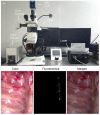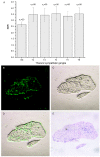Near-infrared Intraoperative Imaging of Thoracic Sympathetic Nerves: From Preclinical Study to Clinical Trial
- PMID: 29290809
- PMCID: PMC5743549
- DOI: 10.7150/thno.22369
Near-infrared Intraoperative Imaging of Thoracic Sympathetic Nerves: From Preclinical Study to Clinical Trial
Abstract
The sympathetic nervous system controls and regulates the activities of the heart and other organs. Sympathetic nervous system dysfunction leads to disease. Therefore, intraoperative real-time imaging of thoracic sympathetic nerves (ITSN) would be of great clinical significance for diagnosis and therapy. The aim of this experimental study was to evaluate the feasibility and validity of intraoperative ITSN using indocyanine green (ICG).
Methods: ITSN using ICG was performed on 10 rabbits to determine its feasibility. Animals were allocated to two groups. The rabbits in one group received the same dose of ICG, but were observed at different times. The rabbits in the other group were administered different doses of ICG, but were observed at the same time. Signal to background ratio (SBR) was measured in regions of interest in all rabbits. Furthermore, fifteen consecutive patients with pulmonary nodules were intravenously injected with ICG 24 h preoperatively and underwent near-infrared (NIR) fluorescence imaging (FI) thoracoscopic surgeries between July 2015 and June 2016. A novel self-developed NIR and white-light dual-channel thoracoscope system was used. SBRs of thoracic sympathetic nerves were calculated in all patients.
Results: In the preclinical study, we were able to precisely recognize each rabbit's second (T2) to fifth (T5) thoracic ganglia on both sides of the spine using ITSN with ICG. In addition, we explored the relationship between SBR and the injection time of ICG and that between SBR and the dose of ICG. Using the novel dual-channel thoracoscope system, we were able to locate the ganglia from the stellate ganglion (SG) to the sixth thoracic ganglion (T6), as well as the chains between these ganglia in all patients with a high SBR value of 3.26 (standard deviation: 0.57). The pathological results confirmed our findings.
Conclusion: We were able to use ICG FI to distinguish thoracic sympathetic nerves during NIR thoracoscopic surgery. The technique may replace the rib-oriented method as standard practice for mapping the thoracic sympathetic nerves.
Trial registration: ClinicalTrials.gov NCT02084784.
Keywords: indocyanine green.; intraoperative fluorescence imaging; near-infrared; sympathetic nerves; thoracoscopic surgery.
Conflict of interest statement
Competing Interests: The authors have declared that no competing interest exists.
Figures




Similar articles
-
Intraoperative near-infrared fluorescence imaging can identify pelvic nerves in patients with cervical cancer in real time during radical hysterectomy.Eur J Nucl Med Mol Imaging. 2022 Jul;49(8):2929-2937. doi: 10.1007/s00259-022-05686-z. Epub 2022 Mar 1. Eur J Nucl Med Mol Imaging. 2022. PMID: 35230489 Free PMC article. Clinical Trial.
-
The safety and feasibility of intraoperative near-infrared fluorescence imaging with indocyanine green in thoracoscopic sympathectomy for primary palmar hyperhidrosis.Thorac Cancer. 2020 Apr;11(4):943-949. doi: 10.1111/1759-7714.13345. Epub 2020 Feb 15. Thorac Cancer. 2020. PMID: 32061064 Free PMC article.
-
Near-infrared fluorescent image-guided surgery for intracranial meningioma.J Neurosurg. 2018 Feb;128(2):380-390. doi: 10.3171/2016.10.JNS161636. Epub 2017 Apr 7. J Neurosurg. 2018. PMID: 28387632 Free PMC article.
-
Diagnostic value of near-infrared or fluorescent indocyanine green guided sentinel lymph node mapping in gastric cancer: A systematic review and meta-analysis.J Surg Oncol. 2018 Dec;118(8):1243-1256. doi: 10.1002/jso.25285. Epub 2018 Oct 31. J Surg Oncol. 2018. PMID: 30380146
-
Diagnostic value of indocyanine green fluorescence guided sentinel lymph node biopsy in vulvar cancer: A systematic review.Gynecol Oncol. 2021 May;161(2):436-441. doi: 10.1016/j.ygyno.2021.01.031. Epub 2021 Feb 5. Gynecol Oncol. 2021. PMID: 33551201
Cited by
-
Intraoperative near-infrared fluorescence imaging can identify pelvic nerves in patients with cervical cancer in real time during radical hysterectomy.Eur J Nucl Med Mol Imaging. 2022 Jul;49(8):2929-2937. doi: 10.1007/s00259-022-05686-z. Epub 2022 Mar 1. Eur J Nucl Med Mol Imaging. 2022. PMID: 35230489 Free PMC article. Clinical Trial.
-
Efficacy of Near-Infrared Fluorescence Video-Assisted Thoracoscopic Surgery for Small Pulmonary Nodule Resection with Indocyanine Green Inhalation: A Randomized Clinical Trial.Ann Surg Oncol. 2023 Sep;30(9):5912-5922. doi: 10.1245/s10434-023-13753-4. Epub 2023 Jun 30. Ann Surg Oncol. 2023. PMID: 37389655 Clinical Trial.
-
Evaluation of indocyanine green inhalation to detect air leak sites during video-assisted thoracoscopic surgery: a prospective study.BMC Surg. 2025 May 13;25(1):206. doi: 10.1186/s12893-025-02875-z. BMC Surg. 2025. PMID: 40361132 Free PMC article.
-
DeepGuide: a novel wavelength-specific navigation system for membrane visualization in surgery.Int J Surg. 2025 Jun 1;111(6):4039-4042. doi: 10.1097/JS9.0000000000002370. Epub 2025 Apr 1. Int J Surg. 2025. PMID: 40171568 Free PMC article.
-
Real-Time Fluorescence Imaging in Thoracic Surgery.Korean J Thorac Cardiovasc Surg. 2019 Aug;52(4):205-220. doi: 10.5090/kjtcs.2019.52.4.205. Epub 2019 Aug 5. Korean J Thorac Cardiovasc Surg. 2019. PMID: 31403028 Free PMC article.
References
-
- Hashmonai M, Licht PB, Schick CH, Bishof G, Cameron AEP, Connery CP. et al. Late results of endoscopic thoracic sympathectomy for hyperhidrosis and facial blushing (Br J Surg 2011; 98: 1719-1724) Brit J Surg. 2012;99:1719–24. - PubMed
-
- Cerfolio RJ, De Campos JR, Bryant AS, Connery CP, Miller DL, Decamp MM. et al. The Society of Thoracic Surgeons expert consensus for the surgical treatment of hyperhidrosis. Ann Thorac Surg. 2011;91:1642. - PubMed
-
- Nicholas R, Quddus A, Baker DM. Treatment of Primary Craniofacial Hyperhidrosis: A Systematic Review. Am J Clin Dermatol. 2015;16:361–70. - PubMed
-
- Abbate A, Hamza M, Cassano AD, Melchior R, Roberts C, Grizzard J. et al. Sympathectomy as a treatment for refractory coronary artery spasm. Int J Cardiol. 2012;161:7–9. - PubMed
-
- Schwartz PJ, Ackerman MJ. The long QT syndrome: a transatlantic clinical approach to diagnosis and therapy. Eur Heart J. 2013;34:3109–16. - PubMed
Publication types
MeSH terms
Substances
Associated data
LinkOut - more resources
Full Text Sources
Other Literature Sources
Medical
Miscellaneous

